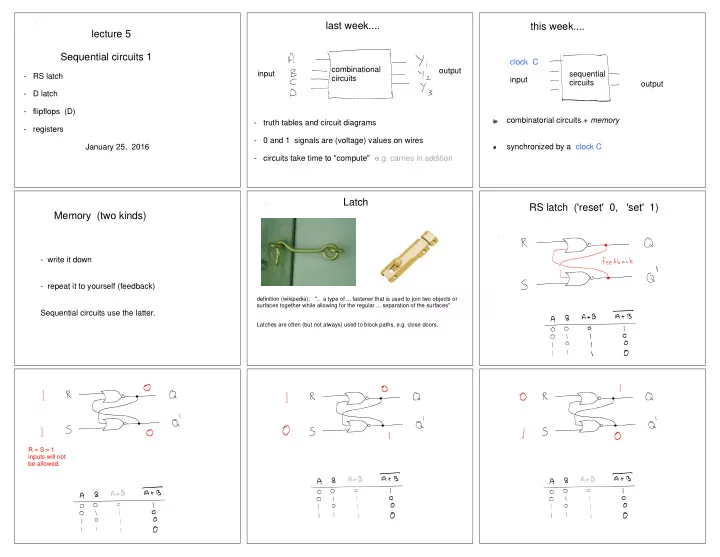

last week.... this week.... lecture 5 Sequential circuits 1 clock C combinational output input sequential - RS latch circuits input circuits output - D latch - flipflops (D) combinatorial circuits + memory - truth tables and circuit diagrams - registers - 0 and 1 signals are (voltage) values on wires synchronized by a clock C January 25, 2016 - circuits take time to "compute" e.g. carries in addition Latch RS latch ('reset' 0, 'set' 1) Memory (two kinds) - write it down - repeat it to yourself (feedback) definition (wikipedia); ".. a type of ... fastener that is used to join two objects or surfaces together while allowing for the regular ... separation of the surfaces" Sequential circuits use the latter. Latches are often (but not always) used to block paths, e.g. close doors. R = S = 1 inputs will not be allowed.
Clock values do not change (memory) - electronic implementation uses "crystal oscillator" https://en.wikipedia.org/wiki/Clock_signal - typical clock speed is in gigaherz (10^9 cycles/sec) Example D latch ("D" is for data) Clocked RS latch What does this circuit do ? D flip flop D latch Example: Suppose we used D latches to store 8 bit numbers A and B. Suppose we added A and B using the circuit below and wrote the new value back into B. Would this work? No, because C = 1 Write D value into first D latch. when C = 1 there would Q doesn't change. be no control over timing and we could loop C = 0 holds values in D latches. (Read only) through multiple times within a single clock pulse C = 0 Stop writing D into first D latch. (while C = 1). The D value from first D latch is written into C = 1 allows values in D latches to go through. second, so Q gets a possibly new value. (Read and write).
D flip flop ("rising edge triggered") D flip flop ("falling edge triggered") Clock cycle must be long enough to allow all gates to stabilize. Clock synchronizes all flipflops, allowing us to treat time as a sequence of discrete read/write steps (hence 'sequential circuit') From now on, By putting the inverter on the first D latch, we would make Q change its value on the rising edge of the clock. There is no - we ignore all variations within a clock cycle advantage to this, so for simplicity we will always work with falling e.g. carries in the adder. edge triggered. I will use this next lecture. - we work only with D flipflops (no more latches) example Shift Right Register (falling edge) Register Shift Right Register (set of flipflops that are read/written together) We can make Q4 have other values e.g. D (variable), 1, 0, Q0. We can then select which of these gets put into the MSB . Example: suppose at t = 0. (Q4, Q3, Q2, Q1, Q0) is (0, 1,0,0,1) D D D flipflop D flipflop flipflop Q4 remains at 0 for the flipflop five clock pulses shown. What happens at each falling edge of clock ? Q4 Shift Left Register Announcements - Quiz 1 and yellow sticky notes Select from: - Assignment 1 - shift left - plan is to post next monday (you'll have ~10 days) - shift right - download logisim from public web page link, Alternatively, physically order the flipflops in the opposite order - write data and familiarize yourself with tutorial - clear - Quizzes 2-6 will take place in ARTS 145 (lastname to be determined - see announcements)
Recommend
More recommend